Are you looking for a versatile addition to your collection of indoor plants to elevate your home decor into a calming oasis?
The sturdy, upright, and variegated leaves of this genus add a perfect touch of a minimalistic vibe and aesthetic appeal, and embrace a dramatic and structural essence to your modern homes.
Be it compact indoor spaces or capacious balcony gardens, there are plenty of Snake Plant varieties that are ideal for small dwellings and modest apartments.
Besides the visual allure, it holds an exceptional ability to fix the indoor air quality and eliminate toxic pollutants, and convert your home into a much healthier environment. You can also count on it as one of the air-purifying bedroom plants that promote sound sleep.
Delve into this article and discover the unique types of Snake Plants and their essential know-how.
Explore the Snake Plant Varieties – A Stylish and Sustainable Choice For Every Home
Snake Plants, also known as mother-in-law’s tongue, Sansevieria, and Snake Tongue, a showy evergreen perennials native to tropical regions of West Africa, including Nigeria and the Congo Republic.
It is also found that Sansevieria, formerly classified as a genus under the Asparagaceae family, has been placed in the genus Dracaena in the year 2017, based on phylogenetic data.
There are at least 70 different types of D. trifasciata that differ in size, shape, and leaves. From tall structural foliage to compact rosettes, let us glance over 15 Snake Plant types that bring beauty and benefits to any home.
Dracaena trifasciata ‘ Laurentii’
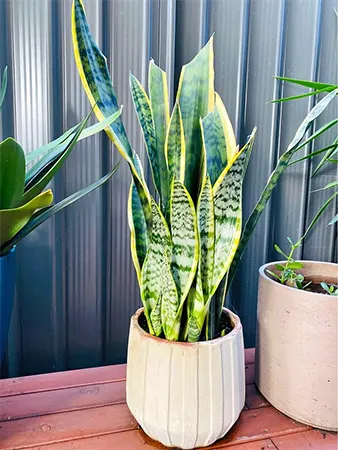
This cultivar is appreciated for its upright sword-like leaves, vigorous yellow variegated edges, and horizontal green stripes. With its low-demanding character, Laurentii is a popular choice amongst novice gardeners as well as seasonal fauna lovers.
| Category | Details |
| Scientific Name | Dracaena trifasciata ‘Laurentii’ |
| Common Name | Variegated Snake Plant, Gold Edged Snake Plant, Mother-In-Law’s Tongue |
| Family | Asparagaceae |
| Origin | Tropical and subtropical regions of West Africa |
| Mature Size | 2-4 feet tall and 2 feet wide, but it is often smaller indoors. |
| Blooms | Indoor specimens rarely bloom, but the mature ones yield greenish white flowers along a slender spike in their native environment. |
| Watering | It can thrive for long stretches without water. Check for dryness of the soil between watering sessions. |
| Soil Type | A well-draining cactus or succulent potting mix is ideal. |
| Temperature | Thrives best in temperatures between 15 °C and 29 °C. Protect it from extreme frosts. |
| Propagation | These can be easily propagated in water as well as soil using leaf cutting, divisions, or rhizome separations. |
Dracaena trifasciata ‘Moonshine’
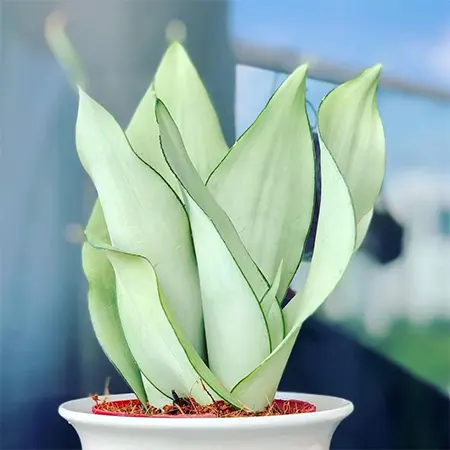
Comparatively, less variegated leaves, along with silverish green foliage and dark green narrow margins, make it an alluring green companion that creates a subtle, soft, minimalistic touch to your modern homes.
It is a popular choice for both beginners and seasoned lovers due to its aesthetic appeal and easy care. The compact size makes these green marvels a perfect fit for tabletops, shelves, and tight spaces.
| Category | Details |
| Scientific Name | Dracaena trifasciata ‘Moonshine’ |
| Common Name | Moonshine Snake Plant, Silver Snake Plant |
| Family | Asparagaceae |
| Origin | Native to tropical West Africa |
| Mature Size | 12-18 inches tall and 6-8 inches wide. |
| Blooms | It rarely blooms, but mature ones may yield white, green flowers in their native surroundings. |
| Watering | Drought tolerant and prefers less watering. |
| Soil Type | Well-draining succulent mix soil is ideal. |
| Temperature | The ideal temperature range is between 18°C – 27°C, protecting it from extreme cold and frosts. |
| Propagation | Easily propagates through leaf cuttings and divisions. |
Dracaena trifasciata ‘Zeylanica’
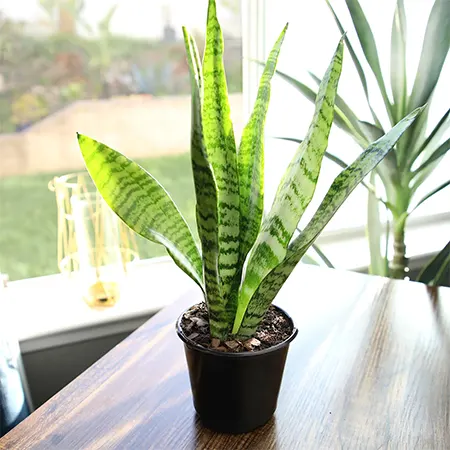
This cultivar is an evergreen perennial with silver and green stripes and pointed edges. It can grace your homes silently without asking much in return.
These are easy to care for, hassle-free, and able to thrive in diverse light and climatic conditions, and elevate any space they are kept in.
| Category | Details |
| Scientific Name | Dracaena trifasciata ‘Zeylanica’ |
| Common Name | Zeylanica Snake Plant, Sansevieria Zeylanica |
| Family | Asparagaceae |
| Origin | Native to Southeast Asia and tropical West Africa. It is commonly found in SriLanka and India. |
| Mature Size | It can grow up to 2-3 feet tall and 2-2.4 inches wide. |
| Blooms | Rare blooms; bears whitish green flowers with mild fragrance. |
| Watering | Water only when the soil seems dry. |
| Soil Type | It grows best in well-draining soil with sand and loam mixed in it. |
| Temperature | Ideal temperature range is between 16 °C – 30 °C; protect from frost temperatures below 10C |
| Propagation | It can easily be propagated using leaf cuttings, divisions, and rhizome separations. |
Dracaena trifasciata ‘Black Gold’
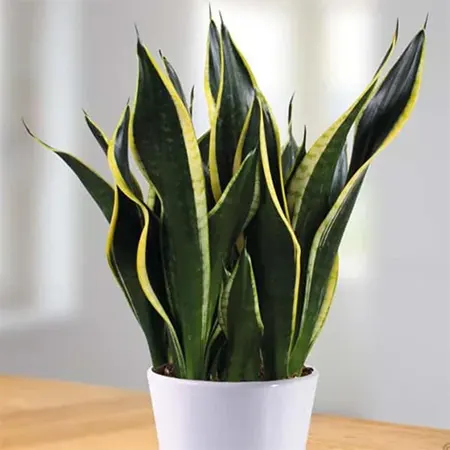
The beautiful natural contrast of dark green foliage and golden margins makes it one of a kind. Besides the visual interest, it is mostly celebrated for its easy-going nature and adaptability. It also eliminates the toxic pollutants and promotes a healthier indoor space.
| Category | Details |
| Scientific Name | Dracaena trifasciana ‘Black Gold’ |
| Common Name | Black Gold Snake Plant, Sansevieria Black Gold, Hahnii Black Gold |
| Family | Asparagaceae |
| Origin | Originates from tropical West Africa, especially from Nigeria, east to the Congo. |
| Mature Size | It grows up to 2-3 feet tall and 1 foot wide. |
| Blooms | Rarely blooms; mature ones may yield white flowers |
| Watering | Monitor the dryness of the soil between watering sessions. Allow the soil to dry out completely. |
| Soil Type | Well-draining cactus or succulent mix soil, where one part is of perlite and sand, and the other part comprises garden soil and peat. |
| Temperature | The ideal temperature range is between 16 °C- 29 °C; it prefers warm conditions and dry air. |
| Propagation | These cultivars can be easily propagated through rhizome separations and mature leaf cuttings. |
Dracaena trifasciata ‘Twisted Sister’
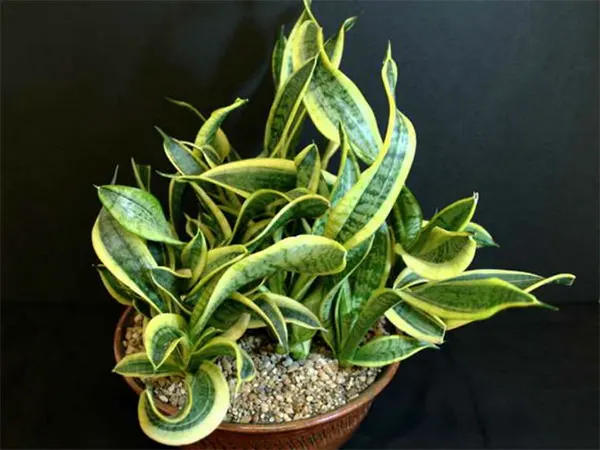
It is one of the compact varieties which features thick, crooked leaves with blunt edges. The vibrant yellow, gold and green variegated foliage brings in a stunning visual appeal.
With minimal care and supervision, these curling beauties are ideal for tabletops, centrepieces, tight corners, and shelves.
| Category | Details |
| Scientific Name | Dracaena trifasciata ‘Twisted Sister’ |
| Common Name | Twisted Sister Snake Plant, Sansevieria Twisted Sister |
| Family | Asparagaceae |
| Origin | Recent development of the broader species that originates in tropical regions of West Africa. |
| Mature Size | It grows up to 10–15 inches tall. |
| Blooms | Rarely blooms; mature ones yield white or greenish flowers very seldom. |
| Watering | Highly adaptable to drought conditions; minimal watering is needed only when the soil dries out completely. |
| Soil Type | A well-draining cactus and succulent soil mixed with perlite and coarse sand is ideal. |
| Temperature | It prospers in an ideal room temperature between 15°C- 27°C; ensure protection in temperatures below 10°C. |
| Propagation | Easily propagates through leaf cutting and divisions. |
Dracaena trifasciata ‘Whitney’
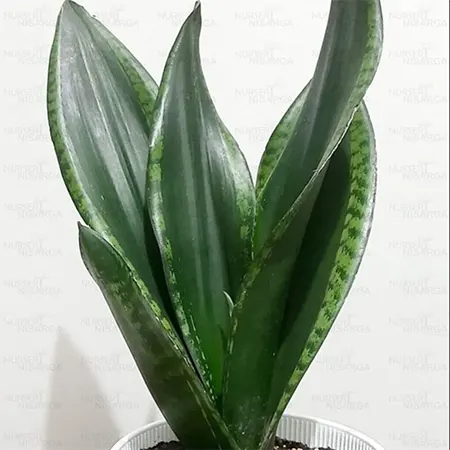
This cultivar is unique in itself, as it limits itself to an average of 4–5 leaves whorled together in a petal-like formation. It features glossy, showy appearance with dark green foliage and silvery green variegations.
The compact nature and low maintenance make it a perfect fit for tight spaces, desks, and windowsills. Besides, it was also a part of the clean air herbage study led by NASA, which found it to be extremely useful in reducing indoor air pollutants.
| Category | Details |
| Scientific Name | Dracaena trifasciata ‘Whitney’ |
| Common Name | Whitney Snake Plant, Silver Flame Snake Plant |
| Family | Asparagaceae |
| Origin | Succulent native to Africa and Madagascar |
| Mature Size | 12-16 inches tall and 6-8 inches wide; ideal for limited space |
| Blooms | Rarely blooms indoors with petite white flowers. |
| Watering | During warm climates, watering once a week is sufficient. |
| Soil Type | A well-draining soil mix with efficient drainage is ideal. |
| Temperature | It prospers in a temperature range of 15 °C- 29 °C, but a sudden drop in temperature can damage the leafy sentinel; protect it from winter drafts and frosts. |
| Propagation | Easily propagates through leaf cutting and rhizome separation. |
Dracaena trifasciata ‘Bantel’s Sensation’
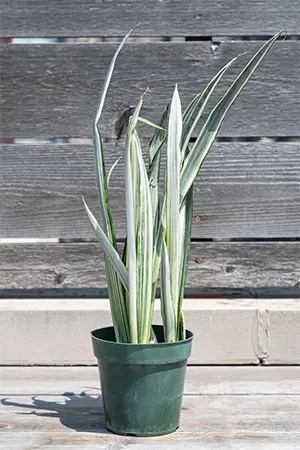
Do you want to bring height and elegance to your room at the same time? Say hello to this amazing cultivar, Bantel’s Sensation. Tall and vertical structure with green foliage and white sleek stripes makes it a standout leafy sentinel.
It is also widely appreciated for its low maintenance and needs, and dramatic contrast, which heightens the place’s charm manyfold.
| Category | Details |
| Scientific Name | Dracaena trifasciata ‘Bantel’s Sensation’ |
| Common Name | White Snake Plant, Bantel’s Sensation Snake Plant |
| Family | Asparagaceae |
| Origin | A cultivar developed through horticultural selective breeding in Missouri, USA. |
| Mature Size | It grows up to 60-90 cm tall and 2-2.5 cm wide. |
| Blooms | Rarely flowers; mature ones yield small white flowers in their native surroundings. |
| Watering | Very minimal watering needs; water only when the soil dries out completely. |
| Soil Type | A well-draining cactus or succulent mix soil is apt for the best results. |
| Temperature | It prefers low humidity and prospers in ideal temperatures between 16 °C and 28 °C. |
| Propagation | Easily propagates through leaf cuttings and rhizome separations. |
Dracaena trifasciata ‘Silver Queen’

As the name suggests, this cultivar is widely celebrated for its silver-green foliage and light green horizontal bands. The tall, flat, sword-shaped leaves and upright stance make it a statement piece for modern homes and aesthetic interiors.
| Category | Details |
| Scientific Name | Dracaena trifasciata ‘Silver Queen’ |
| Common Name | Silver Queen Snake Plant |
| Family | Asparagaceae |
| Origin | Tropical regions of Africa, Southern Asia, and Australia |
| Mature Size | It grows up to 30-90 cm tall and 15-90cm wide. |
| Blooms | Rarely blooms indoors; mature ones bear small, white small fragrant flowers in their native surroundings. |
| Watering | During the dry spells, water them every 2-3 weeks, and during winter, watering once a month is sufficient for the best results. |
| Soil Type | A well-draining cactus and succulents potting mix with proper drainage is apt for growth. |
| Temperature | It prospers under average room temperatures between 16 °C- 29 °C. Ensure to protect it from cold drafts and frosts. |
| Propagation | Easily propagates through leaf cuttings and rhizome divisions. |
Dracaena masoniana (Whale Fin)
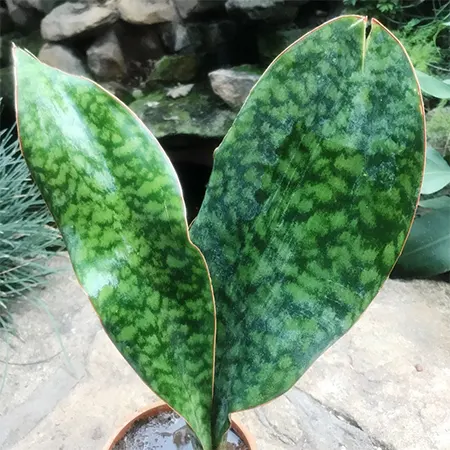
Among all the other Sansevieria varieties, this cultivar is one of the rarest to find. It features enormous paddle-like leaves with a bright green tint, light green blotches, and reddish brown margins.
With a unique demeanor and distinguished personality, it surely is a crown jewel of your indoor fauna collections.
| Category | Details |
| Scientific Name | Dracaena masoniana |
| Common Name | Whale Fin Snake Plant, Mason’s Congo |
| Family | Asparagaceae |
| Origin | It had originated from the Democratic Republic of the Congo. |
| Mature Size | Grows up to 2-4 feet tall and 10-18 inches wide, but each leaf can grow very wide like a whale’s fin. |
| Blooms | Rarely blooms indoors; it may bloom small, fragrant flowers in its native surroundings. |
| Watering | It is drought-tolerant and sensitive to overwatering. Ensure the soil completely dries out between watering sessions. |
| Soil Type | A well-draining succulent and cactus soil mix with some pumice or perlite is ideal for optimum growth. |
| Temperature | Prefers warm climates; a temperature range of 18 °C – 29 °C suits the plan best. It may be sensitive to temperatures below 10°C. |
| Propagation | Easily propagates through leaf cuttings and rhizome divisions. Although the leaf propagation is comparatively slow and tricky. |
Dracaena angolensis
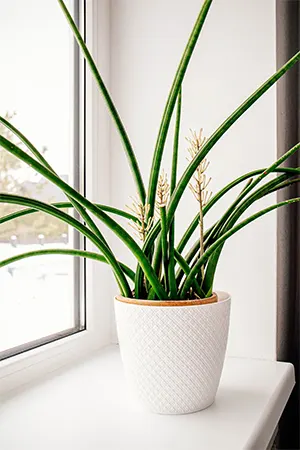
If you are looking to infuse geometry and modern flair into your interior scapes, this cultivar is the perfect choice. It features greyish green colored leaves with dark green stripes, and is structurally stiff, cylindrical, and pointed outwards.
This ornamental sentinel is usually considered slow-growing and is suitable for gracing container pots, indoor areas, and balcony gardens.
| Category | Details |
| Scientific Name | Dracaena angolensis |
| Common Name | Cylindrical Snake Plant, African Spear Plant, Spear Sansevieria |
| Family | Asparagaceae |
| Origin | Angola and the surrounding regions of Southern Africa |
| Mature Size | It can grow up to 4-7 feet tall. Individual leaves can grow around 1-2 inches thick. |
| Blooms | Rarely blooms indoors; mature ones bear off white tabular flowers in their native environment. |
| Watering | It responds well to minimal watering. Monitoring the soil dryness between watering spans is essential for prosperous growth. |
| Soil Type | A well-draining cactus potting mix, or fast-draining sandy and loamy soils, is ideal. |
| Temperature | Thrives in warmer climates, with an ideal temperature range of 18°C – 24°C. It is sensitive to colder climates and should be avoided exposing to temperatures below 10°C. |
| Propagation | Propagates easily through rhizome (underground stems) divisions and cuttings. |
Dracaena trifasciata ‘ Golden Hahnii’
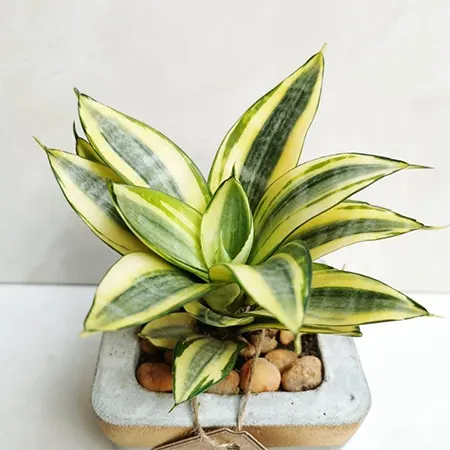
This perennial succulent showcases evergreen foliage with light yellow and creamy white margins that beautifully contrast with the dark green leaves.
Unlike the other tall varieties, Golden Hahnii is a low, dense leafy sentinel that grows in a petal-like formation and resembles a bird’s nest. This dwarf variety can magnify the aesthetics and textures of any place they are put into, without taking up too much space and attention.
| Category | Details |
| Scientific Name | Dracaena trifasciata ‘ Golden Hahnii’ |
| Common Name | Golden Bird’s Nest Snake Plant, |
| Family | Asparagaceae |
| Origin | Originating from tropical and subtropical regions of West Africa, this cultivar has adapted to environments globally. |
| Mature Size | It can grow up to 6-8 inches tall and is similar in width. |
| Blooms | Once matured, it yields fragrant greenish-white flowers initially, and orange berries later in its lifespan. Blooming of fruits and flowers indoors is very rare. |
| Watering | Highly drought-tolerant due to its succulent nature, so ensure to water only when the soil dries out completely. |
| Soil Type | Well-drained sandy soils are best for healthy growth. |
| Temperature | The ideal temperature range lies between 15°C and 29°C. They can tolerate average household humidity, and avoid placing them for prolonged durations in temperatures below 10°C. |
| Propagation | These can easily propagate by separating the offsets (pups) from the base and ensuring each offset has a decent amount of root and fibre. |
Dracaena pethera
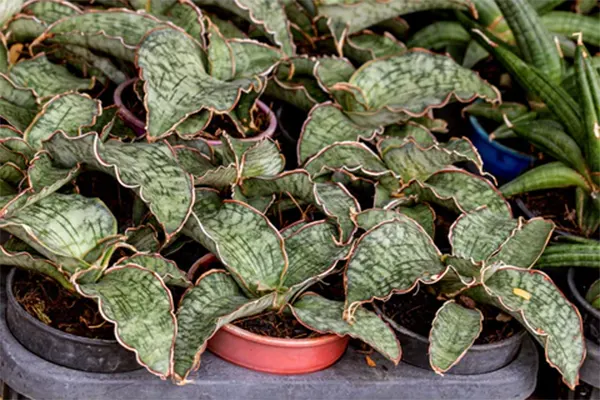
This rare variety of Sansevieria features dark green strap-like leaves with reddish wavy margins and pointed tips, arranged in a petal-like formation.
One of the standout features of this sentinel is that, unlike the other varieties, the leaves tend to droop towards the ground instead of growing upwards. When exposed to bright light, the foliage turns coppery red and pinkish, making it a wow element in any home decor.
| Category | Details |
| Scientific Name | Dracaena pethera |
| Common Name | Star Sansevieria, Kirkii Snake Plant |
| Family | Asparagaceae |
| Origin | East Africa, especially Tanzania and surrounding regions. |
| Mature Size | It can grow up to 1.5 – 2.5 feet tall and wide. |
| Blooms | Blooms with greenish-white fragrant flowers that appear along stems, but very rarely. |
| Watering | Tolerates infrequent watering periods. Let the soil completely dry out before watering. |
| Soil Type | A well-drained sandy and gritty soil mix is ideal for growth. |
| Temperature | Ideal temperature ranges between 18 °C – 30 °C. Temperatures below 5°C can be fatal. |
| Propagation | Easily propagates through rhizome separations and leaf cuttings. |
Dracaena parva
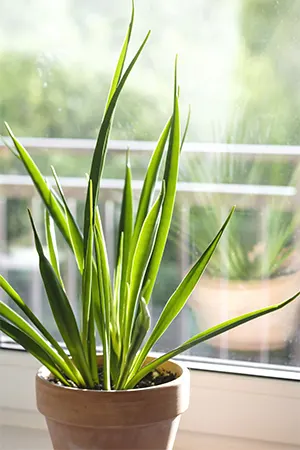
This is one of the rare Snake Plant varieties that can thrive both indoors and outdoors. With its delicate, fragrant flowers resembling hyacinth, it is a blooming success often compared to a flower bulb. Its leaves are usually bright green, contrasting perfectly with pale green bands.
Defined by a low-growing form, sweet fragrance, and unique foliage, it is mostly desirable for gracing tabletops, shelves, and succulent arrangements.
| Category | Details |
| Scientific Name | Dracaena parva |
| Common Name | Kenya Hyacinth, Sansevieria parva |
| Family | Asparagaceae |
| Origin | Originates from East Africa, especially Kenya, Rwanda, and Uganda. |
| Mature Size | A compact variety that can grow up to 1.5 -2 feet tall. |
| Blooms | It is known for its fragrant pale pink and white flowers, resembling Hyacinth. |
| Watering | Responds well to infrequent watering. Ensure to moisten only when the soil dries out completely. |
| Soil Type | A well-draining loamy and sandy soil mix is perfect for lush growth. |
| Temperature | They grow best in temperatures between 21°C and 32°C. Freezing temperatures below 10°C can cause them to suffer and die back. |
| Propagation | It can easily be propagated from offsets and rhizome separation. |
Dracaena francisii
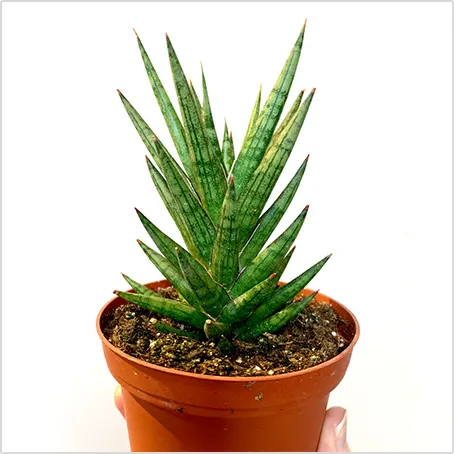
Portrayed by its upright sword-like leaves and dense formations, these spiky marvels are a rare variety to find. It features tabular green foliage, greyish green horizontal bands, and brownish pointed tips.
The compact size makes it ideal for terrarium plant collections, tabletops, centrepieces, and other tight spaces in your homes. It also aids in purifying the air pollutants and enhances the decor without asking much in return.
| Category | Details |
| Scientific Name | Dracaena francisii |
| Common Name | Francisii Snake Plant, Sansevieria francisii |
| Family | Asparagaceae |
| Origin | It originated from East Africa, especially Kenya. |
| Mature Size | Grows up to 1-2 feet tall and wide. |
| Blooms | It rarely blooms with greenish white flowers in a tabular formation. |
| Watering | Ensure watering abruptly only when the soil seems completely dry. Overwatering can damage the leaves. |
| Soil Type | A well-draining succulent or cactus mix potting soil is apt. |
| Temperature | Adapts well to average household humidity and can thrive in temperatures 18°C – 30°C. Prolonged exposure to freezing climates can damage them. |
| Propagation | It can be propagated through leaf cuttings and rhizome divisions. |
Dracaena pinguicula

This perennial succulent is one of the rare varieties that is characterized by a thick, plumpy appearance, with greenish blue leaves, and reddish brown margins and tips.
One of the noticeable features is that leaves are arranged in two rows on opposite sides of the stem. Its unusual growth habits make it a botanical curiosity for flora and fauna lovers.
| Category | Details |
| Scientific Name | Dracaena pinguicula |
| Common Name | Walking Sansevieria, Pinguicula, Snake Plant |
| Family | Asparagaceae |
| Origin | Semi-arid regions in Kenya |
| Mature Size | It can grow up to 1 foot tall, 0.3 metres wide. |
| Blooms | Rarely flowers under cultivation. It is found that it seldom bears brownish blooms in a tabular arrangement. |
| Watering | Ensure to water sparingly and allow the soil to dry out completely. |
| Soil Type | A well-draining soil with a sandy mix. |
| Temperature | It can thrive best in temperatures between 16°C and 27°C. Prolonged exposure to freezing temperatures below 10°C can cause them to suffer. |
| Propagation | Easily propagates through rhizome divisions and stolons, the roots that creep above the ground. |
Some of the other noticeable varieties are Black Jack, Concinna, Black Robusta, Golden Flame, Futura Superba, Black Limon, and the list continues.
From tall, compact, to rare, bold architectural varieties, each Snake Plant has its glory and charm. Different from each other in appearance and features, they all share outstanding qualities like resilience, low maintenance, and air-purifying ability. Have you picked your favourite yet?
Botanical Background of Snake Plants
This architectural succulent features sword-shaped uptight leaves and web-like underground roots with distinctive appeal. It tends to produce white and pale green flowers occasionally in small clusters, which might change into tiny orange colored fruits.
To further appreciate this timeless beauty, let’s delve into its botanical history and profile.
| Taxonomic Overview of the Snake Plant | |
| Kingdom | Plantae |
| Clade | Tracheophytes |
| Clade | Angiosperms |
| Clade | Monocots |
| Order | Asparagales |
| Family | Asparagaceae |
| Genus | Dracaena |
| Species | D.trifasciata |
| Plant Type | Evergreen Perennial, usually grown indoors |
| Common Names | Mother-in-Law Plant, Mother-in-Law’s Tongue, Saint George’s Sword, Viper’s Bowstring Hemp, Sansevieria trifasciata |
Similar to other plants like Dracaena and Foxtail Fern, which belong to the same family, Asparagaceae, these sentinels share similar traits and are low-maintenance, hardy specimens with strap-like upright leaves that can immediately transform your home garden and enhance the aesthetics of the place.
Significance & Symbolism of Snake Plants – The Striped Beauty
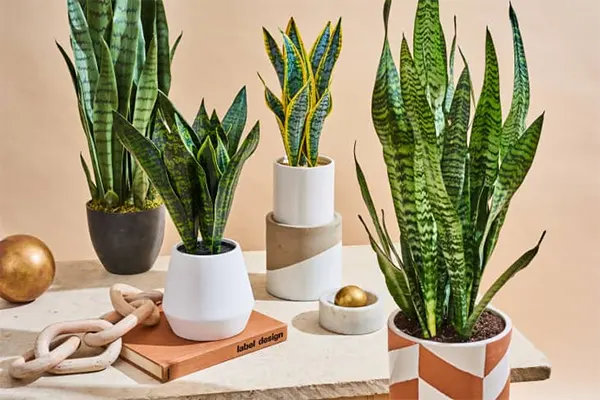
Distinguished yellow striped leaves and tiny pale green flowers of Mother-In-Law’s Tongue, backed by its undemanding nature, purifying abilities, and aesthetic appeal, make it one of the most loved green companions worldwide.
Beyond the amazing health benefits of keeping this living plant in your home, it uplifts the ambience of any space through its majestic presence. Moreover, it also holds a special symbolic meaning and cultural significance worldwide.
Let us uncover the hidden symbolism behind these botanical marvels.
- Restore Positive Energy: The upright sword-like leaves of these ornamental evergreens are found to eliminate negative energy and the presence of evil spirits, restoring positivity.
- Good Fortune and Prosperity: Keeping some types of Snake Plant, like Sansevieria Laurentii, at home and office brings a bundle of good luck and prosperity.
- Resilience and Endurance: Whether common or a rare Snake Plant variety, the hardy and drought-tolerant nature of it symbolises perseverance, resilience, and endurance as it survives in extreme conditions, strong and upright.
As per the Feng Shui principles, these are found to bring in maximum positivity when placed either in the entrance or at any east and south-eastern corners of your home. They infuse natural elegance and promote a subtle calmness amidst an uncluttered lifestyle.
Do You Know?
- The Snake Plant Feng Shui symbolism is associated with protection, positivity, and purity. This is the reason why they are one of the most adorable and preferred houseplants.
- Similar to indoor vine plants like Jade and Christmas Cactus, and other varieties of Cactus, these also keep their stomata closed during the day to reduce the loss of water.
What are the Benefits of Keeping Different Snake Plants in Your Home?
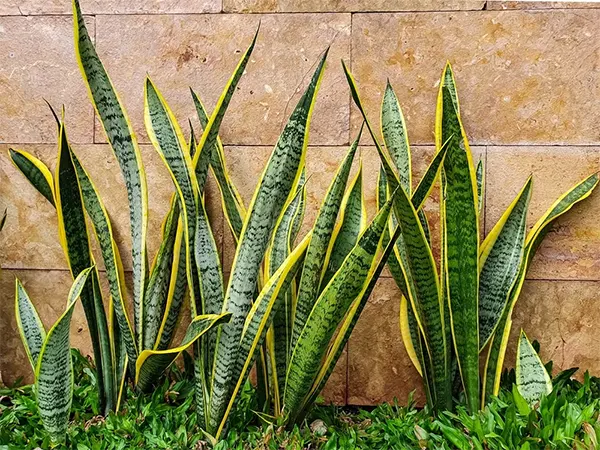
Do you know that these tough-leaf beauties are one of the few plants that release oxygen even at night? Similar to its few green friends like Spider plants, Aloe vera, Peace Lilies, and orchids, these also open their pores at night to release fresh oxygen due to a process called CAM photosynthesis.
Let us explore the mind-boggling benefits of keeping these green companions in your home below in our blog.
- Air Purification: They are found to eliminate toxic pollutants like formaldehyde, benzene, and xylene and spread a wave of fresh air in your home.
- Low-Maintenance and Drought-Tolerant: All the varieties of this genus are easy to maintain and prefer infrequent watering. Their ease of care motivates novice gardeners to bring them home, and garden enthusiasts to balance their busy lives with houseplant care.
- Easy Adaptability: These are highly adaptable to various light and soil conditions. Whether placed indoors or outdoors, they can grace any corner and space they are placed in.
- Improves Humidity Naturally: The gentle release of moisture during transpiration helps them act as natural humidifiers. This aids in climates with dry spells.
- Reduces Stress: It is found that the green appeal of these leafy sentinels is associated with reduced stress levels and improved mental wellness.
With their diverse benefits and aesthetic appeal, they add a touch of elegance and display of year-long interest to any space. You can easily place them in patios, balconies, and elevate your outdoor living areas.
How to Care For Snake Plants? Explore the Essential Guide For a Healthy Plant
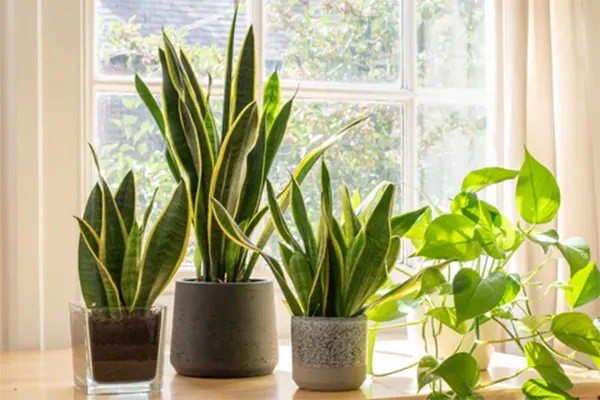
Viper’s Bowstring Hemp is widely appreciated not just for its looks, but also for the ease of care and longevity. These attributes have made it a popular choice amongst gardeners and plant lovers.
Ahead, take a look at the ultimate guidelines on how to grow and care for your green companion.
| Growing and Caring Guidelines for Dracaena trifasciata | |
| Light |
|
| Watering |
|
| Soil |
|
| Temperature |
|
| Fertilizer |
|
| Pruning |
|
| Propagation |
|
Like all, these Mother-In-Law’s Tongue also have their share of drawbacks. These are rarely susceptible to pests and diseases, but sometimes, the plants may be damaged due to infestations from spider mites and mealybugs.
You can get rid of fungus and gnats easily by wiping the leaves with insecticidal soaps and neem oil.
Do You Know?
If you are a pet parent, keep your dogs and cats away from these leafy sentinels. As per ASPCA, they contain saponins, which cause gastrointestinal disorders if ingested.
Wrapping Up the Snake Plant’s Journey – From Dessert To Decor
All the Snake Plants varieties are truly a green gem for your living space. Radiating resilience and alluring appeal, their striking presence can accent not only your home decor but also benefit you in amazing ways by promoting a healthier indoor atmosphere.
They are like a mother’s unconditional love, that exists as a loyal green companion without many demands. Whether a hobby gardener or a seasoned green lover, it is an absolute eye candy houseplant that elevates your home with minimal effort.
Take this article on a journey to grow and celebrate these timeless beauties in your homes and surroundings.
Are Snake Plants safe for pets?
No, these plants are not considered safe for pets, as they can cause gastrointestinal discomfort on ingestion.
How to prevent my plant from turning yellow?
These plants do not require much watering. Overwatering can turn the lush leaves yellow. Ensure to water only when the soil dries out completely.
Does Viper’s Bowstring Hemp grow fast?
They are usually considered slow to moderate growers. Optimal growth conditions and good care can speed up growth during summer.
How to propagate Snake Plants?
You can easily propagate these plants in soil or water through leaf cuttings, divisions, and rhizome separations.
- Snake Plant – A Forgiving Low-Maintenance Houseplant – Penn State Extension
- Snake Plant (Dracaena) – New York Botanical Garden
- Sansevieria– Britannica



